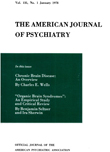Principles and practice of conjoint psychoanalytic treatment
Abstract
The authors describes the advantages of conjoint analytic treatment, which occurs when two or more analysts treat a patient in different settings: one provides the one-to-one relationship, and the other leads the group experience. The goal of this treatment is to increase the therapeutic possibilities for the patient. The advantages come from the use of multiple settings, transferences, observers, interpreters, and maturational agents. The author illustrates the advantages of the treatment with several case reports. He also points out the value of conjoint treatment for the analysts involved.
Access content
To read the fulltext, please use one of the options below to sign in or purchase access.- Personal login
- Institutional Login
- Sign in via OpenAthens
- Register for access
-
Please login/register if you wish to pair your device and check access availability.
Not a subscriber?
PsychiatryOnline subscription options offer access to the DSM-5 library, books, journals, CME, and patient resources. This all-in-one virtual library provides psychiatrists and mental health professionals with key resources for diagnosis, treatment, research, and professional development.
Need more help? PsychiatryOnline Customer Service may be reached by emailing [email protected] or by calling 800-368-5777 (in the U.S.) or 703-907-7322 (outside the U.S.).



